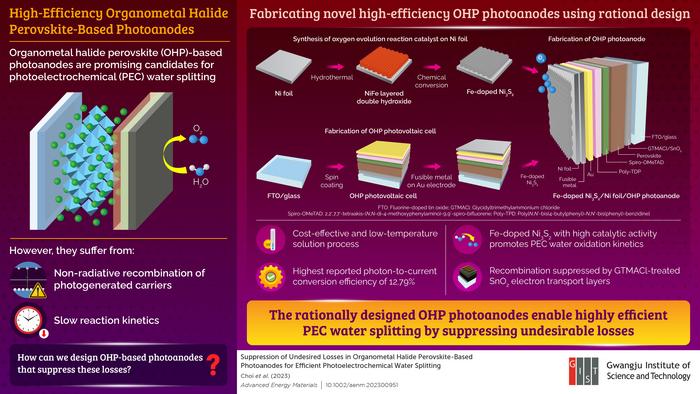Currently, hydrogen is mainly produced by natural gas, which, unfortunately, also generates greenhouse gases such as carbon dioxide as by-products. Scientists argue that hydrogen produced this way, while economical, is not truly sustainable, and thus requires a more eco-friendly approach for its generation. Photoelectrochemical (PEC) water splitting based on solar energy is one such promising approach. However, its widespread application is limited by a lack of efficient photoanodes for catalyzing the rate-limiting oxygen evolution reaction (OER), an important reaction in PEC water splitting.

Credit: Professor Sanghan Lee from Gwangju Institute of Science and Technology, Korea
Currently, hydrogen is mainly produced by natural gas, which, unfortunately, also generates greenhouse gases such as carbon dioxide as by-products. Scientists argue that hydrogen produced this way, while economical, is not truly sustainable, and thus requires a more eco-friendly approach for its generation. Photoelectrochemical (PEC) water splitting based on solar energy is one such promising approach. However, its widespread application is limited by a lack of efficient photoanodes for catalyzing the rate-limiting oxygen evolution reaction (OER), an important reaction in PEC water splitting.
Recently, organometal halide perovskites (OHPs) have emerged as a promising photoanode material on this front. Unfortunately, OHP-based photoanodes suffer from two undesired losses that limit their efficiency. One is an internal loss resulting from a recombination of photogenerated charge carriers (required for electricity generation) within the anode itself, which, in turn, hinders water splitting. The other is external loss due to the slow reaction kinetics of water splitting, resulting in a loss of charge carriers at the interface of the anode and electrolyte.
Against this background, a team of researchers from Korea and USA, led by Professor Sanghan Lee from Gwangju Institute of Science and Technology and including Associate Professor Jangwon Seo from Korea Advanced Institute of Science and Technology, has now developed a highly efficient OHP-based photoanode using a rational design approach, which overcomes the above limitations. Their study was published in the journal Advanced Energy Materials on June 17, 2023.
“The high efficiency of the photoanode for photoelectrochemical water splitting was achieved through the simultaneous suppression of internal and external losses of photogenerated carriers,” highlights Prof. Lee.
In their work, the team fabricated a novel Fe-doped Ni3S2/Ni foil/OHP photoanode in three steps. They first synthesized the Fe-doped Ni3S2 catalyst for OER on Ni foil through a hydrothermal method followed by a chemical conversion. They then separately fabricated the OHP photovoltaic cell consisting of SnO2 electron transport layers (ETLs) through spin coating. Finally, they combined the two components to obtain the photoanode.
The team found that adding glycidyltrimethylammonium chloride (GTMACl) to the anode passivated the defects at the OHP/ETL interface, effectively suppressing the undesired charge carrier recombination within the anode. Further, it enhanced the light-soaking stability of the OHP cell, a crucial factor in real-world PEC water splitting. Additionally, the high catalytic activity of Fe-doped Ni3S2 ensured a high OER rate at the anode, reducing the loss of photogenerated carriers within the electrolyte.
Consequently, the Fe-doped Ni3S2/Ni foil/OHP photoanode exhibited an unprecedented applied bias photon-to-current conversion efficiency of 12.79%, higher than that reported for OHP-based photoanodes in existing studies.
Overall, this study provides important insights into the prospects of rationally designed OHP-based photoelectrodes, as Prof. Lee highlights: “The proposed technology is expected to contribute to the vitalization of the hydrogen economy and carbon neutrality by enabling a large-scale and eco-friendly hydrogen production using solar energy without external voltage in the next 10 years. This, in turn, will help realize hydrogen as an ideal renewable source of energy in the future.”
And we sure hope the researcher’s vision is realized soon!
***
Reference
DOI: https://doi.org/10.1002/aenm.202300951
About the Gwangju Institute of Science and Technology (GIST)
The Gwangju Institute of Science and Technology (GIST) is a research-oriented university situated in Gwangju, South Korea. Founded in 1993, GIST has become one of the most prestigious schools in South Korea. The university aims to create a strong research environment to spur advancements in science and technology and to promote collaboration between international and domestic research programs. With its motto of “A Proud Creator of Future Science and Technology,” GIST has consistently received one of the highest university rankings in Korea.
Website: http://www.gist.ac.kr/
About the authors
Jangwon Seo is an Associate Professor at the Department of Chemical and Biomolecular Engineering at Korea Advanced Institute of Science and Technology (KAIST). He received his Ph.D. degree from Seoul National University and completed his postdoctoral training from the University at Buffalo, State University of New York. Before coming to KAIST, he worked at the Korea Research Institute of Science and Technology as a senior researcher. His group currently develops perovskite solar cells and organic electronic materials.
Sanghan Lee is a Professor at the School of Materials Science and Engineering at Gwangju Institute of Science and Technology (GIST). He received a Ph. D. degree and completed his postdoctoral training from the University of Wisconsin-Madison. His group develops photoelectrodes for photoelectrochemical water splitting.
*Corresponding authors’ emails: [email protected] (J. Seo), [email protected] (S. Lee)
Journal
Advanced Energy Materials
DOI
10.1002/aenm.202300951
Method of Research
Experimental study
Subject of Research
Not applicable
Article Title
Suppression of Undesired Losses in Organometal Halide Perovskite-Based Photoanodes for Efficient Photoelectrochemical Water Splitting
Article Publication Date
17-Jun-2023
COI Statement
The authors declare no conflict of interest.




